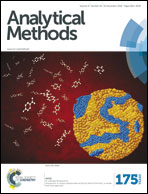Facile synthesis of Ni(OH)2 nanoplates on nitrogen-doped carbon foam for nonenzymatic glucose sensors
Abstract
In this work, ultrathin Ni(OH)2 nanoplates uniformly anchored on nitrogen-doped carbon foam (NCF) were facilely prepared for the construction of nonenzymatic glucose biosensors. The Ni(OH)2/NCF hybrid was prepared by the pyrolysis of melamine foam (utilizing it as a template) followed by the growth of Ni(OH)2 nanoplates via a microwave process. The Ni(OH)2/NCF with three-dimensional macroporous and hierarchical architectures can provide continuous channels for the rapid diffusion of an electrolyte to access the electrochemically active sites of Ni(OH)2 nanoplates. Moreover, the NCF with abundant active sites can effectively prevent the agglomeration of Ni(OH)2, and also could be a conductive core providing efficient electron transport for the fast redox reactions of Ni(OH)2. Being employed as a nonenzymatic glucose detection electrochemical electrode, it exhibits a wide linear response ranging from 5 µM to 9.15 mM, and a low detection limit (0.8 µM) with excellent selectivity. Meanwhile, the sensor was also applied to the detection of glucose content in real serum samples with satisfactory results. The simple preparation procedure, low cost, and enhanced electrocatalytic performance potentially pave a new, effective and promising way for highly sensitive glucose sensors.


 Please wait while we load your content...
Please wait while we load your content...